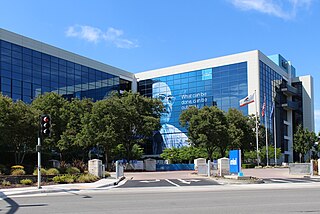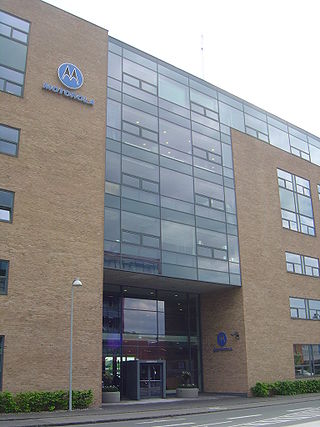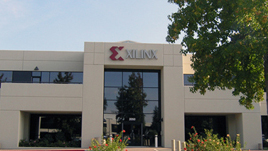Related Research Articles

Advanced Micro Devices, Inc. (AMD) is an American multinational corporation and semiconductor company based in Santa Clara, California, that develops computer processors and related technologies for business and consumer markets.

Intel Corporation is an American multinational corporation and technology company headquartered in Santa Clara, California, and incorporated in Delaware. Intel is one of the world's largest semiconductor chip manufacturers by revenue and ranked in the Fortune 500 list of the largest United States corporations by revenue for nearly a decade, from 2007 to 2016 fiscal years, until it was removed from the ranking in 2018. In 2020, it was reinstated and ranked 45th, being the 7th-largest technology company in the ranking.

Motorola, Inc. was an American multinational telecommunications company based in Schaumburg, Illinois. It was founded in 1928 as Galvin Manufacturing Corporation by brothers Paul and Joseph Galvin. The company changed its name to Motorola in 1947. After having lost $4.3 billion from 2007 to 2009, Motorola was split into two independent public companies, Motorola Mobility and Motorola Solutions, on January 4, 2011. The reorganization was structured with Motorola Solutions legally succeeding Motorola, Inc., and Motorola Mobility being spun off.

Xilinx, Inc. was an American technology and semiconductor company that primarily supplied programmable logic devices. The company is known for inventing the first commercially viable field-programmable gate array (FPGA). It also created the first fabless manufacturing model.
Derrick R. "Dirk" Meyer is a former Chief Executive Officer of Advanced Micro Devices, serving in the position from July 18, 2008 to January 10, 2011.
Eugene Collins Pulliam was an American newspaper publisher and businessman who was the founder and president of Central Newspapers Inc., a media holding company. During his sixty-three years as a newspaper publisher, Pulliam acquired forty-six newspapers across the United States. Major holdings of Central Newspapers, which he founded in 1934, included the Indianapolis Star, the Indianapolis News, the Arizona Republic, and the Phoenix Gazette, as well as newspapers in smaller cities in Indiana, Arizona, and other states. Pulliam's early career included work as a reporter for the Kansas City Star and as editor and publisher of the Atchison (Kansas) Daily Champion. Prior to 1960 Pulliam also operated radio stations WAOV and WIRE in Indiana and KTAR in Arizona. The Kansas native, a graduate from DePauw University in 1910, founded the DePauw Daily, an independent student newspaper, and in 1909 was one of ten DePauw students who cofounded Sigma Delta Chi, a journalism fraternity that was later renamed the Society of Professional Journalists. In August 2000, the Gannett Company acquired Central Newspapers for US$2.6 billion, with the Eugene C. Pulliam Trust as the principal beneficiary of the sale.
Philco is an American electronics manufacturer headquartered in Philadelphia. Philco was a pioneer in battery, radio, and television production. In 1961, the company was purchased by Ford and, from 1966, renamed "Philco-Ford". Ford sold the company to GTE in 1974, and it was purchased by Philips in 1981. In North America, the Philco brand is owned by Philips. In other markets, the Philco International brand is owned by Electrolux.

International Rectifier was an American power management technology company manufacturing analog and mixed-signal ICs, advanced circuit devices, integrated power systems, and high-performance integrated components for computing. On 13 January 2015, the company became a part of Infineon Technologies.

Ralph Haver (1915–1987) was an American architect working in metropolitan Phoenix, Arizona from 1945 until the early 1980s. Haver designed the Mid-Century Modern Haver Homes, affordable tract housing executed in a contemporary modern style.
ON Semiconductor Corporation is an American semiconductor supplier company, based in Scottsdale, Arizona. Products include power and signal management, logic, discrete, and custom devices for automotive, communications, computing, consumer, industrial, LED lighting, medical, military/aerospace and power applications. onsemi runs a network of manufacturing facilities, sales offices and design centers in North America, Europe, and the Asia Pacific regions. Based on its 2016 revenues of $3.907 billion, onsemi ranked among the worldwide top 20 semiconductor sales leaders, and was ranked No. 483 on the 2022 Fortune 500 based on its 2021 sales.

Vishay Intertechnology, Inc. is an American manufacturer of discrete semiconductors and passive electronic components founded by Polish-born businessman Felix Zandman. Vishay has manufacturing plants in Israel, Asia, Europe, and the Americas where it produces rectifiers, diodes, MOSFETs, optoelectronics, selected integrated circuits, resistors, capacitors, and inductors. Vishay Intertechnology revenues for 2023 were $3.4 billion. At the end of 2023, Vishay had approximately 23,500 full-time employees.

Mark D. Papermaster is an American business executive who is the chief technology officer (CTO) and executive vice president for technology and engineering at Advanced Micro Devices (AMD). On January 25, 2019 he was promoted to AMD's Executive Vice President. Papermaster previously worked at IBM from 1982 to 2008, where he was closely involved in the development of PowerPC technology and was two years as vice president of IBM's blade server division. Papermaster's decision to move from IBM to Apple Inc. in 2008 became central to a court case considering the validity and scope of an employee non-compete clause in the technology industry. He became senior vice president of devices hardware engineering at Apple in 2009, with oversight for devices such as the iPhone. In 2010 he left Apple and joined Cisco Systems as a VP of the company's silicon engineering development. Papermaster joined AMD on October 24, 2011, assuming oversight for all of AMD's technology teams and the creation of all of AMD's products, and AMD's corporate technical direction.

James L. Buie was an American scientist and inventor working for TRW Inc who developed transistor–transistor logic, a form of integrated circuit technology that became widely used early in the integrated circuit industry.

Edward Leighton Varney Jr. (1914–1998) was an American Modernist architect working in Phoenix, Arizona from 1937 until his retirement in 1985. He designed the Hotel Valley Ho in Scottsdale, and Sun Devil Stadium at Arizona State University. In 1941, he began his career, which would extend to his retirement in 1985. His firm would continue designing buildings into the 1990s.

Thomas Stuart Montgomery (1917-1970) was an American architect working in Washington D.C. and Arizona during the middle 20th century. His offices were located in Old Town Scottsdale and later in downtown Tempe. He is known for designing Saint Barnabas On The Desert Episcopal Church in Paradise Valley.

Fred Melville Guirey (1908-1984) was an architect working in Phoenix Arizona from the 1930s to the 1980s. Over his career his firm produced many works some of which are considered exceptional examples of Mid-Century Modern, and Brutalist architecture.

Robert W. Pickrell was an American lawyer and politician who served as the Attorney General of Arizona from 1961 to 1965.
DWL Architects + Planners Inc., is an architecture and planning firm headquartered in Phoenix, Arizona. The firm was founded in 1949 by Frederick Penn Weaver and Richard E. Drover as the firm Weaver & Drover. It later became Drover, Welch & Lindlan Architects and was then shortened to DWL. The firm has designed many noteworthy buildings throughout the state of Arizona.
References
- ↑ Business record details for American Micro Devices, Inc., Minnesota Secretary of State
- ↑ "NEW CONCERN FORMED; American Micro Devices to Make Electronic Items". The New York Times . 1961. Retrieved March 22, 2019.
- 1 2 "CANNON GROUP SUIT DRAWING TO A CLOSE U.S. COURT MUST DECIDE WHETHER TO APPROVE OR MODIFY SETTLEMENT". www.orlandosentine.com. Orlando Sentinel. August 10, 1988. Retrieved March 22, 2019.
- 1 2 "Modern Electronics Plant Begins Production Here" . www.newspapers.com. Arizona Republic. May 25, 1962. Retrieved March 29, 2019.
- ↑ "Micro Holds First Session Of Group". www.newspapers.com. Arizona Republic. August 5, 1962. Retrieved March 29, 2019.
- ↑ "Firm Adds Rectifiers". www.newspapers.com. Arizona Republic. February 12, 1963. Retrieved March 29, 2019.
- 1 2 "American Micro Buys Rectifier". www.newspapers.com. The Minneapolis Star. November 1, 1962. Retrieved March 29, 2019.
- ↑ "California Firm Purchased". Arizona Republic . October 6, 1962. Retrieved March 29, 2019.
- ↑ "Sylvania to Market for Micro Devices". www.newspapers.com. Star Tribune. January 21, 1964. Retrieved March 29, 2019.
- ↑ "Firm Plans to Quit". www.newspapers.com. Arizona Republic. March 8, 1965. Retrieved March 29, 2019.
- ↑ "Public Auction". www.newspapers.com. Arizona Daily Star. May 9, 1965. Retrieved March 29, 2019.
- ↑ "AVON'S SHARES NOT RINGING ANY BELLS". www.chicagotribune.com. Chicago Tribune. July 25, 1988.